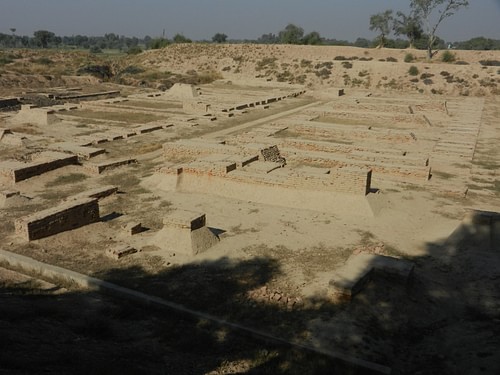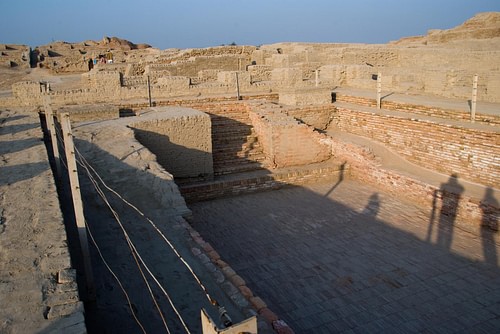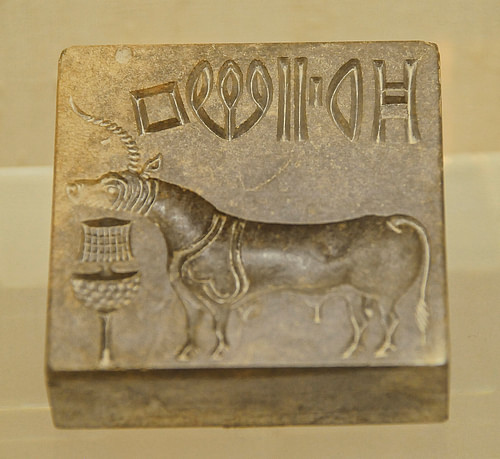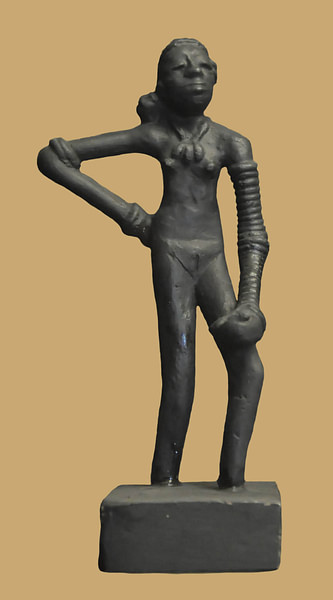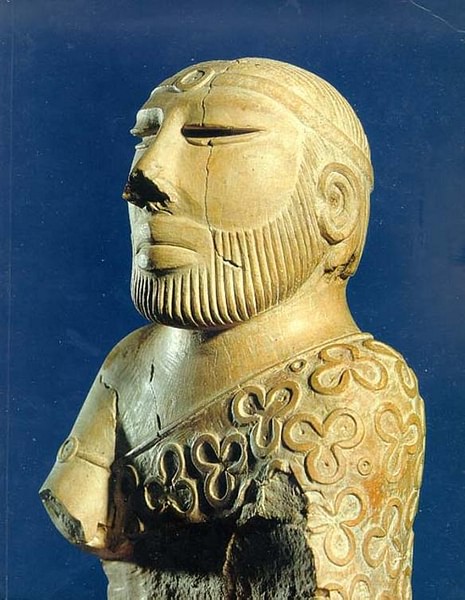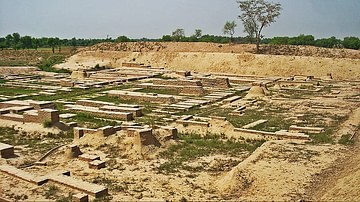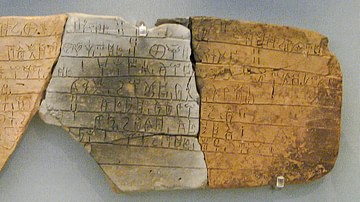
The Indus Valley Civilization was a cultural and political entity which flourished in the northern region of the Indian subcontinent between c. 7000 - c. 600 BCE. Its modern name derives from its location in the valley of the Indus River, but it is also commonly referred to as the Indus-Sarasvati Civilization and the Harrapan Civilization.
These latter designations come from the Sarasvati River mentioned in Vedic sources, which flowed adjacent to the Indus River, and the ancient city of Harappa in the region, the first one found in the modern era. None of these names derive from any ancient texts because, although scholars generally believe the people of this civilization developed a writing system (known as Indus Script or Harappan Script) it has not yet been deciphered.
All three designations are modern constructs, and nothing is definitively known of the origin, development, decline, and fall of the civilization. Even so, modern archaeology has established a probable chronology and periodization:
- Pre-Harappan – c. 7000 - c. 5500 BCE
- Early Harappan – c. 5500 - 2800 BCE
- Mature Harappan – c. 2800 - c. 1900 BCE
- Late Harappan – c. 1900 - c. 1500 BCE
- Post Harappan – c. 1500 - c. 600 BCE
The Indus Valley Civilization is now often compared with the far more famous cultures of Egypt and Mesopotamia, but this is a fairly recent development. The discovery of Harappa in 1829 CE was the first indication that any such civilization existed in India, and by that time, Egyptian hieroglyphics had been deciphered, Egyptian and Mesopotamian sites excavated, and cuneiform would soon be translated by the scholar George Smith (l. 1840-1876 CE). Archaeological excavations of the Indus Valley Civilization, therefore, had a significantly late start comparatively, and it is now thought that many of the accomplishments and “firsts” attributed to Egypt and Mesopotamia may actually belong to the people of the Indus Valley Civilization.
The two best-known excavated cities of this culture are Harappa and Mohenjo-daro (located in modern-day Pakistan), both of which are thought to have once had populations of between 40,000-50,000 people, which is stunning when one realizes that most ancient cities had on average 10,000 people living in them. The total population of the civilization is thought to have been upward of 5 million, and its territory stretched over 900 miles (1,500 km) along the banks of the Indus River and then in all directions outward. Indus Valley Civilization sites have been found near the border of Nepal, in Afghanistan, on the coasts of India, and around Delhi, to name only a few locations.
Between c. 1900 - c. 1500 BCE, the civilization began to decline for unknown reasons. In the early 20th century CE, this was thought to have been caused by an invasion of light-skinned peoples from the north known as Aryans who conquered a dark-skinned people defined by Western scholars as Dravidians. This claim, known as the Aryan Invasion Theory, has been discredited. The Aryans – whose ethnicity is associated with the Iranian Persians – are now believed to have migrated to the region peacefully and blended their culture with that of the indigenous people while the term Dravidian is understood now to refer to anyone, of any ethnicity, who speaks one of the Dravidian languages.
Why the Indus Valley Civilization declined and fell is unknown, but scholars believe it may have had to do with climate change, the drying up of the Sarasvati River, an alteration in the path of the monsoon which watered crops, overpopulation of the cities, a decline in trade with Egypt and Mesopotamia, or a combination of any of the above. In the present day, excavations continue at many of the sites found thus far and some future find may provide more information on the history and decline of the culture.
Discovery & Early Excavation
The symbols and inscriptions on the artifacts of the people of the Indus Valley Civilization, which have been interpreted by some scholars as a writing system, remain undeciphered and so archaeologists generally avoid defining an origin for the culture as any attempt would be speculative. All that can be known of the civilization to date comes from the physical evidence excavated at various sites. The story of the Indus Valley Civilization, therefore, is best given with the discovery of its ruins in the 19th century CE.
James Lewis (better known as Charles Masson, l. 1800-1853 CE) was a British soldier serving in the artillery of the East India Company Army when, in 1827 CE, he deserted with another soldier. In order to avoid detection by authorities, he changed his name to Charles Masson and embarked on a series of travels throughout India. Masson was an avid numismatist (coin collector) who was especially interested in old coins and, in following various leads, wound up excavating ancient sites on his own. One of these sites was Harappa, which he found in 1829 CE. He seems to have left the site fairly quickly, after making a record of it in his notes but, having no knowledge of who could have built the city, wrongly attributed it to Alexander the Great during his campaigns in India c. 326 BCE.

When Masson returned to Britain after his adventures (and having been somehow forgiven his desertion), he published his book Narrative of Various Journeys in Balochistan, Afghanistan and the Punjab in 1842 CE which attracted the attention of the British authorities in India and, especially, Alexander Cunningham. Sir Alexander Cunningham (l. 1814-1893 CE), a British engineer in the country with a passion for ancient history, founded the Archaeological Survey of India (ASI) in 1861 CE, an organization dedicated to maintaining a professional standard of excavation and preservation of historic sites. Cunningham began excavations of the site and published his interpretation in 1875 CE (in which he identified and named the Indus Script) but this was incomplete and lacked definition because Harappa remained isolated with no connection to any known past civilization which could have built it.
In 1904 CE, a new director of the ASI was appointed, John Marshall (l. 1876-1958 CE), who later visited Harappa and concluded the site represented an ancient civilization previously unknown. He ordered the site to be fully excavated and, at about the same time, heard of another site some miles away which the local people referred to as Mohenjo-daro (“the mound of the dead”) because of bones, both animal and human, found there along with various artifacts. Excavations at Mohenjo-daro began in the 1924-1925 season and the similarities of the two sites were recognized; the Indus Valley Civilization had been discovered.
Harappa & Mohenjo-daro
The Hindu texts known as the Vedas, as well as other great works of Indian tradition such as the Mahabharata and Ramayana, were already well known to Western scholars but they did not know what culture had created them. Systemic racism of the time prevented them from attributing the works to the people of India, and the same, at first, led archaeologists to conclude that Harappa was a colony of the Sumerians of Mesopotamia or perhaps an Egyptian outpost.
Harappa did not conform to either Egyptian or Mesopotamian architecture, however, as there was no evidence of temples, palaces, or monumental structures, no names of kings or queens or stelae or royal statuary. The city spread over 370 acres (150 hectares) of small, brick houses with flat roofs made of clay. There was a citadel, walls, the streets were laid out in a grid pattern clearly demonstrating a high degree of skill in urban planning and, in comparing the two sites, it was apparent to the excavators that they were dealing with a highly advanced culture.
Houses in both cities had flush toilets, a sewer system, and fixtures on either side of the streets were part of an elaborate drainage system, which was more advanced even than that of the early Romans. Devices known from Persia as “wind catchers” were attached to the roofs of some buildings which provided air conditioning for the home or administrative office and, at Mohenjo-daro, there was a great public bath, surrounded by a courtyard, with steps leading down into it.
As other sites were unearthed, the same degree of sophistication and skill came to light as well as the understanding that all of these cities had been pre-planned. Unlike those of other cultures which usually developed from smaller, rural communities, the cities of the Indus Valley Civilization had been thought out, a site chosen, and purposefully constructed prior to full habitation. Further, they all exhibited conformity to a single vision which further suggested a strong central government with an efficient bureaucracy that could plan, fund, and build such cities. Scholar John Keay comments:
What amazed all these pioneers, and what remains the distinctive characteristic of the several hundred Harappan sites now known, is their apparent similarity: “Our overwhelming impression is of cultural uniformity, both throughout the several centuries during which the Harappan civilization flourished, and over the vast area it occupied.” The ubiquitous bricks, for instance, are all of standardized dimensions, just as the stone cubes used by the Harappans to measure weights are also standard and based on the modular system. Road widths conform to a similar module; thus, streets are typically twice the width of side lanes, while the main arteries are twice or one and a half times the width of streets. Most of the streets so far excavated are straight and run either north-south or east-west. City plans therefore conform to a regular grid pattern and appear to have retained this layout through several phases of building. (9)
Excavations at both sites continued between 1944-1948 CE under the direction of the British archaeologist Sir Mortimer Wheeler (l. 1890-1976 CE) whose racialist ideology made it difficult for him to accept that dark-skinned people had built the cities. Even so, he managed to establish stratigraphy for Harappa and lay the foundation for the later periodization of the Indus Valley Civilization.
Chronology
Wheeler's work provided archaeologists with the means to recognize approximate dates from the civilization's foundations through its decline and fall. The chronology is primarily based, as noted, on physical evidence from Harappan sites but also from knowledge of their trade contacts with Egypt and Mesopotamia. Lapis lazuli, to name only one product, was immensely popular in both cultures and, although scholars knew it came from India, they did not know from precisely where until the Indus Valley Civilization was discovered. Even though this semi-precious stone would continue to be imported after the fall of the Indus Valley Civilization, it is clear that, initially, some of the export came from this region.
- Pre-Harappan – c. 7000 - c. 5500 BCE: The Neolithic period best exemplified by sites like Mehrgarh which shows evidence of agricultural development, domestication of plants and animals, and production of tools and ceramics.
- Early Harappan – c. 5500-2800 BCE: Trade firmly established with Egypt, Mesopotamia, and possibly China. Ports, docks, and warehouses built near waterways by communities living in small villages.
- Mature Harappan – c. 2800 - c. 1900 BCE: Construction of the great cities and widespread urbanization. Harappa and Mohenjo-daro are both flourishing c. 2600 BCE. Other cities, such as Ganeriwala, Lothal, and Dholavira are built according to the same models and this development of the land continues with the construction of hundreds of other cities until there are over 1,000 of them throughout the land in every direction.
- Late Harappan – c. 1900 - c. 1500 BCE: Decline of the civilization coinciding with a wave of migration of the Aryan people from the north, most likely the Iranian Plateau. Physical evidence suggests climate change which caused flooding, drought, and famine. A loss of trade relations with Egypt and Mesopotamia has also been suggested as a contributing cause.
- Post Harappan – c. 1500 - c. 600 BCE: The cities are abandoned, and the people have moved south. The civilization has already fallen by the time Cyrus II (the Great, r. c. 550-530 BCE) invades India in 530 BCE.

Aspects of Culture
The people seem to have been primarily artisans, farmers, and merchants. There is no evidence of a standing army, no palaces, and no temples. The Great Bath at Mohenjo-daro is believed to have been used for ritual purification rites related to religious belief but this is conjecture; it could as easily have been a public pool for recreation. Each city seems to have had its own governor but, it is speculated, there must have been some form of centralized government in order to achieve the uniformity of the cities. John Keay comments:
Harappan tools, utensils, and materials confirm this impression of uniformity. Unfamiliar with iron – which was nowhere known in the third millennium BC – the Harappans sliced, scraped, beveled, and bored with 'effortless competence' using a standardized kit of tools made from chert, a kind of quartz, or from copper and bronze. These last, along with gold and silver, were the only metals available. They were also used for casting vessels and statuettes and for fashioning a variety of knives, fishhooks, arrowheads, saws, chisels, sickles, pins, and bangles. (10)
Among the thousands of artifacts discovered at the various sites are small, soapstone seals a little over an inch (3 cm) in diameter which archaeologists interpret to have been used for personal identification in trade. Like the cylinder seals of Mesopotamia, these seals are thought to have been used to sign contracts, authorize land sales, and authenticate point-of-origin, shipment, and receipt of goods in trade long distance.
The people had developed the wheel, carts drawn by cattle, flat-bottomed boats wide enough to transport trade goods, and may have also developed the sail. In agriculture, they understood and made use of irrigation techniques and canals, various farming implements, and established different areas for cattle grazing and crops. Fertility rituals may have been observed for a full harvest as well as pregnancies of women as evidenced by a number of figurines, amulets, and statuettes in female form. It is thought that the people may have worshipped a Mother Goddess deity and, possibly, a male consort depicted as a horned figure in the company of wild animals. The religious beliefs of the culture, however, are unknown and any suggestions must be speculative.
Their level of artistic skill is evident through numerous finds of statuary, soapstone seals, ceramics, and jewelry. The most famous artwork is the bronze statuette, standing 4 inches (10 cm) tall, known as “Dancing Girl” found at Mohenjo-daro in 1926 CE. The piece shows a teenage girl, right hand on her hip, left on her knee, with chin raised as though evaluating the claims of a suitor. An equally impressive piece is a soapstone figure, 6 inches (17 cm) tall, known as the Priest-King, depicting a bearded man wearing a headdress and ornamental armband.
A particularly interesting aspect of the artwork is the appearance of what seems to be a unicorn on over 60 percent of the personal seals. There are many different images on these seals but, as Keay notes, the unicorn appears on "1156 seals and sealings out of a total of 1755 found at Mature Harappan sites" (17). He also notes that the seals, no matter what image appears on them, also have markings which have been interpreted as Indus Script, suggesting that the “writing” conveys a meaning different from the image. The “unicorn” could possibly have represented an individual's family, clan, city, or political affiliation and the “writing” one's personal information.
Decline & Aryan Invasion Theory
Just as there is no definitive answer to the question of what the seals were, what the “unicorn” represented, or how the people venerated their gods, there is none for why the culture declined and fell. Between c. 1900 - c. 1500 BCE, the cities were steadily abandoned, and the people moved south. As noted, there are a number of theories concerning this, but none are completely satisfactory. According to one, the Gaggar-Hakra River, which is identified with the Sarasvati River from Vedic texts, and which ran adjacent to the Indus River, dried up c. 1900 BCE, necessitating a major relocation of the people who had depended on it. Significant silting at sites such as Mohenjo-daro suggests major flooding which is given as another cause.
Another possibility is a drop in necessary trade goods. Both Mesopotamia and Egypt were experiencing troubles during this same time which could have resulted in a significant disruption in trade. The Late Harappan Period corresponds roughly with the Middle Bronze Age in Mesopotamia (2119-1700 BCE) during which the Sumerians – the major trading partners with the people of the Indus Valley – were engaged in driving out the Gutian invaders and, between c. 1792-1750 BCE, the Babylonian king Hammurabi was conquering their city-states as he consolidated his empire. In Egypt, the period corresponds to the latter part of the Middle Kingdom (2040-1782 BCE) when the weak 13th Dynasty ruled just prior to the coming of the Hyksos and the central government's loss of power and authority.
The reason which early 20th century CE scholars seized on, however, was none of these but the claim that the Indus Valley people had been conquered and driven south by an invasion of a superior race of light-skinned Aryans.
Aryan Invasion Theory
Western scholars had been translating and interpreting the Vedic literature of India for over 200 years by the time Wheeler was excavating the sites and, in that time, came to develop the theory that the subcontinent was at some point conquered by a light-skinned race known as Aryans who established high culture throughout the land. This theory developed slowly and, at first, innocently through the publication of a work by the Anglo-Welsh philologist Sir William Jones (l. 1746-1794 CE) in 1786 CE. Jones, an avid reader of Sanskrit, noted that there were remarkable similarities between it and European languages and claimed there had to be a common source for all of them; he called this source Proto-Indo-European.
Later Western scholars, trying to identify Jones' “common source”, concluded that a light-skinned race from the north – somewhere around Europe – had conquered the lands south, notably India, establishing culture and spreading their language and customs, even though nothing, objectively, supported this view. A French elitist writer named Joseph Arthur de Gobineau (l. 1816-1882 CE) popularized this view in his work An Essay on the Inequality of the Human Races in 1855 CE and asserted that superior, light-skinned, races had “Aryan blood” and were naturally disposed to rule over lesser races.
Gobineau's book was admired by the German composer Richard Wagner (l. 1813-1883 CE) whose British-born son-in-law, Houston Stewart Chamberlain (l. 1855-1927 CE) further popularized these views in his work which would eventually influence Adolf Hitler and the architect of the Nazi ideology, Alfred Rosenberg (l. 1893-1946 CE). These racialist views were given further validity by a German philologist and scholar who did not share them, Max Muller (l. 1823-1900 CE), the so-called “author” of the Aryan Invasion Theory who insisted, in all of his work, that Aryan had to do with a linguistic difference and had nothing at all to do with ethnicity.
It hardly mattered what Muller said, however, because, by the time Wheeler was excavating the sites in the 1940s CE, people had been breathing in these theories with the air of the times for well over 50 years. It would be decades more before the majority of scholars, writers, and academics would begin to recognize that 'Aryan' originally referred to a class of people – having nothing to do with race – and, in the words of the archaeologist J. P. Mallory, “as an ethnic designation the word [Aryan] is most properly limited to the Indo-Iranians” (Farrokh, 17). The early Iranians self-identified as Aryan meaning “noble” or “free” or “civilized” and the term continued in use for over 2000 years until it was corrupted by European racists to serve their own agenda.
Wheeler's interpretation of the sites was informed by and then validated the Aryan Invasion Theory. The Aryans were already recognized as the authors of the Vedas and other works but their dates in the region were too late to support the claim that they had built the impressive cities; perhaps, though, they had destroyed them. Wheeler was, of course, as aware of the Aryan Invasion Theory as any other archaeologist at the time and, through this lens, interpreted what he found as supporting it; in doing so, he validated the theory which then gained greater popularity and acceptance.
Conclusion
The Aryan Invasion Theory, though still cited and advanced by those with a racialist agenda, lost credence in the 1960s CE through the work, primarily, of the American archaeologist George F. Dales who reviewed Wheeler's interpretations, visited the sites, and found no evidence to support it. The skeletons Wheeler had interpreted as dying a violent death in battle showed no such signs nor did the cities exhibit any damage associated with war.
Further, there was no evidence of any kind of mobilization of a great army of the north nor of any conquest c. 1900 BCE in India. The Persians – the only ethnicity self-identifying as Aryan – were themselves a minority on the Iranian Plateau between c. 1900 - c. 1500 BCE and in no position to mount an invasion of any kind. It was therefore suggested that the “Aryan Invasion” was actually most likely a migration of Indo-Iranians who merged peacefully with the indigenous people of India, intermarried, and were assimilated into the culture.
As excavations of the sites of the Indus Valley Civilization continue, more information will no doubt contribute to a better understanding of its history and development. Recognition of the culture's vast accomplishments and high level of technology and sophistication has been increasingly coming to light and gaining greater attention. Scholar Jeffrey D. Long expresses the general sentiment, writing, “there is much fascination with this civilization because of its high level of technological advancement” (198). Already, the Indus Valley Civilization is referenced as one of the three greatest of antiquity alongside Egypt and Mesopotamia, and future excavations will almost surely elevate its standing even higher.
